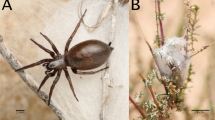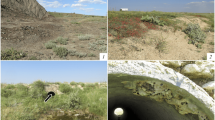Abstract
Mature colonies of Discothyrea oculata were observed nesting in cribellatid spider oothecas where they found both shelter and food although these oothecas, installed in preexisting cavities, were protected with crimped silk. Workers of colonies bred in test tubes during laboratory experiments recuperated the silk from spider oothecas introduced into their foraging area, using their mandibles and forelegs, to operculate and line the test tubes. Also, colonies left the test tubes to shelter in the cribellatid spider oothecas. The term "arachnolesty" is proposed for this new kind of lestobiosis.
Similar content being viewed by others
Author information
Authors and Affiliations
Additional information
Received: 20 April 1998 / Accepted in revised form: 16 October 1998
Rights and permissions
About this article
Cite this article
Dejean, A., Grimal, A., Malherbe, MC. et al. From Specialization in Spider Egg Predation to an Original Nesting Mode in a "Primitive" Ant: A New Kind of Lestobiosis. Naturwissenschaften 86, 133–137 (1999). https://doi.org/10.1007/s001140050585
Issue Date:
DOI: https://doi.org/10.1007/s001140050585




